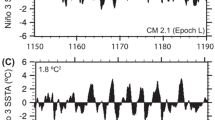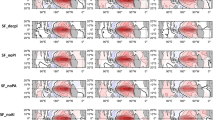Abstract
Inverse methods are used to investigate changes in the precursors to El Niño Southern Oscillation (ENSO) events since the so-called 1970’s climate shift, associated with a change in the phase of the Interdecadal Pacific Oscillation (IPO). Linear Inverse Models (LIMs) constructed from tropical sea surface temperature, thermocline depth and zonal wind stress anomalies from each of the periods 1959–1978 and 1979–1998, are able to reproduce the major observed characteristics of ENSO, including its amplitude, frequency and time evolution. Each LIM possesses low-frequency and biennial ENSO modes, the former being both the least damped and the mode responsible for strongest pseudoresonance, as quantified via calculation of the resolvent norm. Because these modes are damped, ENSO variability is sustained in the stochastically forced LIMs by transiently growing perturbations, and predictability is determined by the character of the transiently growing subspace of perturbations. The optimal linear precursor over any given lead time is equivalent to the optimal perturbation of the LIM, that represents the most rapidly growing linear perturbation over that timescale. In both periods linear ENSO growth occurs through one of two trajectories associated with the 7 and 15 month optimal perturbations. The structure of these two optimal perturbations change significantly between the two periods, and their ability to predict ENSO degrades dramatically when applied to the alternate period. This suggests that ENSO precursors changed following the 1970s climate shift over both 7 and 15 month time-scales. In particular, while prior to the climate shift the heat content of the equatorial Pacific alone is a skillful ENSO predictor on 7 month lead times, afterwards Indian and south Atlantic sea surface temperature anomalies are inferred to have become important. Optimal ENSO growth over 15 months also contains a significant extra-Pacific contribution, and it is possible to skillfully hindcast some (but not all) ENSO events in both periods over 15 month lead times. Of the four considered linear precursors, only the 7 month optimal perturbation corresponding to the period 1959–1978 is able to skillfully hindcast ENSO amplitude from 1998 to the present, correctly predicting the development of El Niño conditions since February 2014. As such the optimal precursor structure appears to be related to the phase of the IPO, and we conjecture that extra-Pacific teleconnections may gain importance during a positive phase of the IPO.















Similar content being viewed by others
References
Aiken CM, Santoso A, McGregor S, England MH (2013) The 1970s shift in ENSO dynamics: a linear inverse model perspective. Geophys Res Lett 40:1612–1617. doi:10.1002/grl.50264
Alexander MA, Matrosova L, Penland C, Scott JD, Chang P (2008) Forecasting Pacific SSTs: linear inverse model predictions of the PDO. J Clim 21:385–402
An S-I, Jin F-F (2000) An eigenanalysis of the interdecadal changes in the structure and frequency of ENSO Mode. Geophys Res Lett 27:1573–2576
An S-I, Ye Z, Hsieh WW (2006) Changes in the leading ENSO modes associated with the late 1970s climate shift: role of surface zonal current. Geophys Res Lett 33:L14609. doi:10.1029/2006GL026604
Behringer DW, Xue Y (2004) Evaluation of the global ocean data assimilation system at NCEP: the Pacific Ocean. In: Eighth symposium on integrated observing and assimilation systems for atmosphere, oceans, and land surface, AMS 84th annual meeting, Washington State Convention and Trade Center, Seattle, Washington, pp 11–15
Bjerknes J (1969) Atmospheric teleconnections from the equatorial Pacific. Mon Weather Rev 97:163–172
Boschat G, Terray P, Masson S (2013) Extratropical forcing of ENSO. Geophys Res Lett 40:1605–1611. doi:10.1002/grl.50229
Carton JA, Giese BS (2008) A reanalysis of ocean climate using Simple Ocean Data Assimilation (SODA). Mon Weather Rev 136:2999–3017
Clarke AJ, Van Gorder S (2003) Improving El Niño prediction using a space-time integration of Indo-Pacific winds and equatorial Pacific upper ocean heat content. Geophys Res Lett 30:1399. doi:10.1029/2002GL016673
Deser C, Phillips AS, Alexander MA (2010) Twentieth century tropical sea surface temperature trends revisited. Geophys Res Lett 37:L10701. doi:10.1029/2010GL043321
Dommenget D, Semenov V, Latif M (2006) Impacts of the tropical Indian and Atlantic oceans on ENSO. Geophys Res Lett 33(L11):701. doi:10.1029/2006GL025871
Eisenman I, Yu L, Tziperman E (2005) Westerly wind bursts: ENSO’s tail rather than the dog? J Clim 18:5224–5238
England MH, McGregor S, Spence P, Meehl GA, Timmermann A, Cai W, Sen Gupta A, McPhaden MJ, Purich A, Santoso A (2014) Recent intensification of wind-driven circulation in the Pacific and the ongoing warming hiatus. Nat Clim Change. doi:10.1038/nclimate2106
Farrell BF, Ioannou PJ (1996) Generalized stability theory. Part I: autonomous operators. J Atmos Sci 53:2025–2040
Farrell BF, Ioannou PJ (2001) Accurate low-dimensional approximation of the linear dynamics of fluid flow. J Atmos Sci 58:2771–2789
Fedorov AV, Philander SGH (2000) Is El Niño changing? Science 288:1997–2002
Fedorov AV, Philander SG (2001) A stability analysis of tropical ocean-atmosphere interactions: bridging measurements and theory for El Nino. J Clim 14:3086–3101
Frauen C, Dommenget D (2012) Influences of the tropical Indian and Atlantic Oceans on the predictability of ENSO. Geophys Res Lett 39:L02706. doi:10.1029/2011GL050520
Giese BS, Chepurin GA, Carton JA, Boyer TP, Seidel HF (2010) Impact of bathythermograph temperature bias models on an ocean reanalysis. J Clim 24:84–93. doi:10.1175/2010JCLI3534.1
Izumo T, Vialard J, Lengaigne M, de Boyer Montegut C, Behera SK, Luo JJ, Cravatte S, Masson S, Yamagata T (2010) Influence of the state of the Indian Ocean dipole on the following years El Ñino. Nat Geosci 3:168–172. doi:10.1038/ngeo760
Jansen MF, Dommenget D, Keenlyside N (2009) Tropical Atmosphere-Ocean interactions in a conceptual framework. J Climate 22(3):550–567
Jin FF (1997) An equatorial ocean recharge paradigm for ENSO. Part I: conceptual model. J Atmos Sci 54:811–829
Keenlyside N, Latif M (2007) Understanding equatorial Atlantic interannual variability. J Clim 20:131–142
Keenlyside N, Ding H, Latif M (2013) Potential of equatorial Atlantic variability to enhance El Niño prediction. Geophys Res Lett 40:2278–2283
Kirtman BP, Schopf PS (1998) Decadal variability in ENSO predictability and prediction. J Clim 11:2804–2822
Kug J-S, Kang I-S (2006) Interactive feedback between ENSO and the Indian Ocean. J Clim 19:1784–1801. doi:10.1175/JCLI3660.1
Latif M, Anderson D, Barnett T, Cane M, Kleeman R, Leetmaa A, O’Brien J, Rosati A, Schneider E (1998) A review of the predictability and prediction of ENSO. J Geophys Res 103(C7):14375–14393. doi:10.1029/97JC03413
McGregor S, Timmermann A, England MH, Elison Timm O, Wittenberg AT (2013) Inferred changes in El Nio-Southern oscillation variance over the past six centuries. Clim Past Discuss 9:2929–2966
McPhaden MJ (2012) A 21st century shift in the relationship between ENSO SST and warm water volume anomalies. Geophys Res Lett 39:L09706. doi:10.1029/2012GL051826
McPhaden MJ, Zhang X (2009) Asymmetry in zonal phase propagation of ENSO sea surface temperature anomalies. Geophys Res Lett 36:L13703. doi:10.1029/2009GL038774
McPhaden MJ, Zebiak SE, Glantz MH (2006) ENSO as an integrating concept in Earth science. Science 314:1740–1745
McPhaden MJ, Lee T, McClurg D (2011) El Niño and its relationship to changing background conditions in the tropical Pacific Ocean. Geophys Res Lett 38:L15709. doi:10.1029/2011GL048275 (2011)
Meinen CS, McPhaden MJ (2000) Observations of warm water volume changes in the equatorial pacific and their relationship to El Nino and La Nina. J Clim 13:3551–3559
Michaelsen J (1987) Cross-validation in statistical climate forecast models. J Clim Appl Meteorol 26:1589–1600
Mielke PW Jr, Berry KJ, Landsea CW (1996) Artificial skill and validation in meteorological forecasting. Weather Forecast 11:153–169
Moore A, Kleeman R (1999) The non-normal nature of El Nino and intraseasonal variability. J Clim 12:2965–2982
Neelin JD, Battisti DS, Hirst A, Jin F-F, Wakata Y, Yamagata T, Zebiak SE (1998) ENSO theory. J Geophys Res 103:14261–14290
Newman M, Sardeshmukh PD, Winkler CR, Whitaker JS (2003) A study of subseasonal predictability. Mon Weather Rev 131:1715–1732
Newman M, Sardeshmukh PD, Penland C (2009) How important is air–sea coupling in ENSO and MJO evolution? J Clim 22:2958–2977
Newman M, Alexander MA, Scott JD (2011a) An empirical model of tropical ocean dynamics. Clim Dyn. doi:10.1007/s00382-011-1034-0
Newman M, Shin S-I, Alexander MA (2011b) Natural variation in ENSO flavors. Geophys Res Lett 38:L14705. doi:10.1029/2011GL047658
Penland C, Magorian T (1993) Prediction of Niño-3 sea surface temperatures using linear inverse modelling. J Clim 6:1067–1076
Penland C, Matrosova L (1994) A balance condition for stochastic numerical models with application to the El Nino-Southern oscillation. J Clim 7:1352–1372
Penland C, Matrosova L (2006) Studies of El Niño and interdecadal variability in Tropical sea surface temperatures using a nonnormal filter. J Clim 19:5796–5815
Penland C, Sardeshmukh PD (1995) The optimal growth of tropical sea surface temperature anomalies. J Clim 8:1999–2024
Power S, Casey T, Folland C, Colman A, Mehta V (1999) Interdecadal modulation of the impact of ENSO on Australia. Clim Dyn 15:319–324
Rodríguez-Fonseca B, Polo I, Garcia-Serrano J, Losada T, Mohino E, Mechoso CR, Kucharski F (2009) Are Atlantic Niños enhancing Pacific ENSO events in recent decades? Geophys Res Lett 36:L20705. doi:10.1029/2009GL040048
Santoso A, England MH, Cai W (2012) Impact of Indo-Pacific feedback interactions on ENSO dynamics diagnosed using ensemble climate simulations. J Clim 25:7743–7763
Santoso A, McGregor S, Jin F-F, Cai W, England MH, An S-I, McPhaden MJ, Guilyardi E (2013) Late-twentieth-century emergence of the El Niño propagation asymmetry and future projections. Nature 504:126–130
Terray P (2011) Southern hemisphere extra-tropical forcing: a new paradigm for El Niño-Southern Oscillation. Clim Dyn 36:2171–2199. doi:10.1007/s00382-010-0825-z
Thompson CJ, Battisti DS (2001) A linear stochastic dynamical model of ENSO. Part II: analysis. J Clim 14:445–466
Tokinaga H, Xie1 S-P, Timmermann A, McGregor S, Ogata T, Kubota H, Okumura YM (2012) Regional patterns of tropical Indo-Pacific climate change: evidence of the Walker circulation weakening. J Clim 25:1689–1710
Trefethen LN (1991) Pseudospectra of matrices. In: Griffiths DF, Watson GA (eds) Numerical analysis. Longman, pp 234–266
Trefethen LN, Trefethen AE, Reddy SC, Driscoll TA (1993) Hydrodynamic stability without eigenvalues. Science 261:578–584
Trenberth KE, Stepaniak DP, Caron JM (2002) Interannual variations in the atmospheric heat budget. J Geophys Res 107(D8):4066. doi:10.1029/2000JD000297
Uppala SM, Kallberg PW, Simmons AJ, Andrae U, Da Costa Bechtold V, Fiorino M, Gibson JK, Haseler J, Hernandez A, Kelly GA, Li X, Onogi K, Saarinen S, Sokka N, Allan RP, Andersson E, Arpe K, Balmaseda MA, Beljaars ACM, Van de Berg L, Bidlot J, Bormann N, Caires S, Chevallier F, Dethof A, Dragosavac M, Fisher M, Fuentes M, Hagemann S, Hólm E, Hoskins BJ, Isaksen L, Janssen PAEM, Jenne R, McNally AP, Mahfouf J-F, Morcrette J-J, Rayner NA, Saunders RW, Simon P, Sterl A, Trenberth KE, Untch A, Vasiljevic D, Viterbo P, Woollen J (2005) Quart J R Meteorol Soc 131:2961–3012
Vecchi GA, Soden BJ, Wittenberg AT, Held IM, Leetmaa A, Harrison MJ (2006) Weakening of tropical Pacific atmospheric circulation due to anthropogenic forcing. Nature 441:73–76
Vimont DJ, Wallace JM, Battisti DS (2003) The seasonal footprinting mechanism in the Pacific: implications for ENSO. J Clim 16:2668–2675
Wang B, An S-I (2002) A mechanism for decadal changes of ENSO behavior: roles of background wind changes. Clim Dyn 18:475–486
Winkler CR, Newman M, Sardeshmukh PD (2001) A linear model of wintertime low-frequency variability. Part I: formulation and forecast skill. J Clim 14:4474–4494
Woodruff SD, Worley SJ, Lubker SJ, Ji Z, Eric Freeman J, Berry DI, Brohan P, Kent EC, Reynolds RW, Smith SR, Wilkinson C (2011) ICOADS Release 2.5: extensions and enhancements to the surface marine meteorological archive. Int J Climatol 31:951–967. doi:10.1002/joc.2103
Xue Y, Leetmaa A, Ji M (2000) ENSO prediction with Markov models: the impact of sea level. J Clim 13:849–871
Zhang H, Clement A, Di Nezio P (2014) The South Pacific Meridional mode: a mechanism for ENSO-like variability. J Clim 27:769–783
Acknowledgments
This work was supported by the Australian Research Council (ARC) including the ARC Centre of Excellence in Climate System Science. We are grateful to three anonymous reviewers for their constructive comments.
Author information
Authors and Affiliations
Corresponding author
Rights and permissions
About this article
Cite this article
Aiken, C.M., Santoso, A., McGregor, S. et al. Optimal forcing of ENSO either side of the 1970’s climate shift and its implications for predictability. Clim Dyn 45, 47–65 (2015). https://doi.org/10.1007/s00382-014-2300-8
Received:
Accepted:
Published:
Issue Date:
DOI: https://doi.org/10.1007/s00382-014-2300-8




